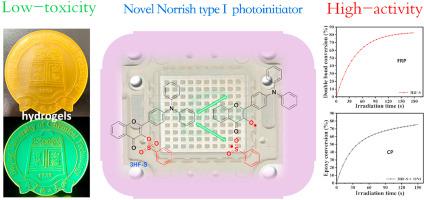Dyes and Pigments ( IF 4.5 ) Pub Date : 2020-09-16 , DOI: 10.1016/j.dyepig.2020.108865 Jian You , Ding Cao , Tianyu Hu , Yaoyao Ye , Xiaoqin Jia , Hui Li , Xiaotong Hu , Yingying Dong , Yufan Ma , Tao Wang

|
In this study, flavonoid with N,N-diphenylamino group, 2-(4-(diphenylamino)phenyl)-3-hydroxy-4H-chromen-4-one (3HF–OH) was designed and synthesized as low-toxicity photoinitiator for photopolymerization under safe visible LED sources, however, low photoinitiation activity of 3HF–OH was found due to the excited state proton transfer (ESIPT) process. Hence, by replacing the 3-position hydroxyl group of 3HF–OH with benzoyl chloride and benzenesulfonyl chloride, flavonol carboxylate (3HF–C) and flavonol sulfonate (3HF–S) were synthesized, respectively. 3HF–C and 3HF–S showed not only one-component photoinitiating activity but also two-component photoinitiating activity when they were used with triethanolamine (TEOA) and iodonium salt (ONI) under safe, long-wavelength LED soft light sources. Photopolymerization kinetics reveals that photoinitiator 3HFs at low concentration exhibits the high polymerization rate and conversion. Results also showed that 3HF–S has much higher photoinitiation activity during photopolymerization compared with 3HF–OH and 3HF–C. The high extinction coefficient and aggregation-induced emission (AIE) characteristics of 3HF–S were observed, which proved that reducing the photoinitiator usage can effectively progress the photopolymerization activity. At the same time, the low usage of 3HF–S further reduces the toxicity of the cured material. Through electron spin resonance (ESR) experiment, the photoinitiation and sensitization mechanisms of these photoinitiators were observed. The school badge structure of hydrogels could be successfully 3D printed with 3HF–S and the stiffness of the structure was sufficient for further processing without breaking the structure. Moreover, the use of the 3-[4,5-dimethylthiazol-2-yl]-2,5-diphenyl tetrazolium bromide (MTT) method confirmed the lower toxicity for the final photopolymer provided.
中文翻译:

新型Norrish I类黄酮类光引发剂,通过抑制ESIPT过程,可提供具有高活性和低毒性的安全LED灯
在这项研究中,具有N,N-二苯氨基,2-(4-(二苯氨基)苯基)-3-羟基-4 H的类黄酮-chromen-4-one(3HF–OH)被设计和合成为低毒性光引发剂,用于在安全可见LED光源下进行光聚合,但是,由于激发态质子转移(ESIPT)过程,发现3HF–OH的光引发活性较低。因此,通过用苯甲酰氯和苯磺酰氯取代3HF-OH的3位羟基,分别合成了黄酮醇羧酸盐(3HF-C)和黄酮醇磺酸盐(3HF-S)。3HF–C和3HF–S在安全的长波长LED柔光光源下与三乙醇胺(TEOA)和碘鎓盐(ONI)一起使用时,不仅表现出单组分光引发活性,而且表现出两组分光引发活性。光聚合动力学表明,低浓度的光引发剂3HF具有较高的聚合速率和转化率。结果还表明,与3HF-OH和3HF-C相比,3HF-S在光聚合过程中具有更高的光引发活性。观察到了3HF-S的高消光系数和聚集诱导发射(AIE)特性,这证明减少光引发剂的使用可以有效地提高光聚合活性。同时,3HF-S的低用量进一步降低了固化材料的毒性。通过电子自旋共振(ESR)实验,观察了这些光引发剂的光引发和敏化机理。水凝胶的校徽结构可以成功地用3HF–S 3D打印,并且结构的刚度足以在不破坏结构的情况下进行进一步处理。此外,使用3- [4,5-二甲基噻唑-2-基] -2


























 京公网安备 11010802027423号
京公网安备 11010802027423号